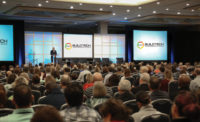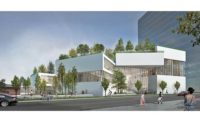Defining a "California design market" has never been simple. From the high-tech centers of the north to the entertainment- and entrepreneurial-focused cities in the south, the Golden State is in many ways a market of markets, each with its distinct taste and requirements.
So it's appropriate that when Gensler, ENR California's 2015 Design Firm of the Year, takes on a new assignment, the company taps into a diverse global network of thought, experience and backgrounds to create buildings that not only meet the client's goals, but also those of the various end users.
"We see ourselves as a constellation of stars—design experts in different areas who have their fingers on the pulse of the latest trends and technologies," says Gensler co-CEO Andy Cohen. "By bringing them together, you achieve a wonderful cross-pollination of ideas and innovation."
Take airport facilities, for example. For the $250-million, 65,000-sq-ft renovation of Terminal 3 at San Francisco International Airport (SFO), the Gensler team included what Scott Dunlap, managing principal for Gensler's Northwest region, calls a "vegetable soup" of disciplines—experts in aviation, commercial buildings, hospitality, retail, graphic art and sustainability. The newly completed terminal features amenities such as a yoga room, private dressing rooms, high-tech gate lounges and an interactive children's play area, plus retail options that help augment the airport's revenue stream.
"Gensler didn't see Terminal 3 as a gigantic architectural project," says Geoff Neumayr, SFO's deputy airport director for design and construction. "They put the right people in the right places to walk with passengers on the journey that begins at the curbside and doesn't end until they're aboard the plane. They met our needs and expectations, but more importantly, they met those of our passengers."
A cross-disciplinary approach is also well-suited to the emergence of mixed-use projects, particularly in Southern California, where developers are moving away from mono-functional buildings, according to Rob Jernigan, Gensler's regional managing principal.
"The market and financiers now understand that mixed-use is essential to giving Los Angeles more of a 24/7 feel, rather than one that becomes a ghost town when people leave at the end of every day," he says.
Few projects evidence that trend better than the $1-billion, 4.3-million-sq-ft Metropolis, which Gensler is designing along with SPAN Architecture. The project's first phase includes a 19-story boutique hotel and 38-story residential tower rising from a 66-ft, above-ground retail podium that Jernigan says "activates the street and makes it a bigger part of the city."
Other Gensler projects planned or under construction include the $961-million Midfield Satellite Concourse design/build project at Los Angeles International Airport via a seven-year joint venture with Corgan, Turner and PCL; the $150-million, 26-story 222 Second Street tower in San Francisco that's aiming for LEED Gold certification; and Market Street Place, a $150-million, six-story urban retail center, also in San Francisco.
Though a firm's size and breadth of resources can be an advantage in pursing large, complex projects, it is by no means the sole determining factor as far as today's clients are concerned, says Dunlap.
"They really want smart partners who are current in thinking and innovative in solutions," he says. "Given the strong focus on sustainable design, for example, there's an expectation that team members are up-to-date on the latest technologies and services."













Post a comment to this article
Report Abusive Comment